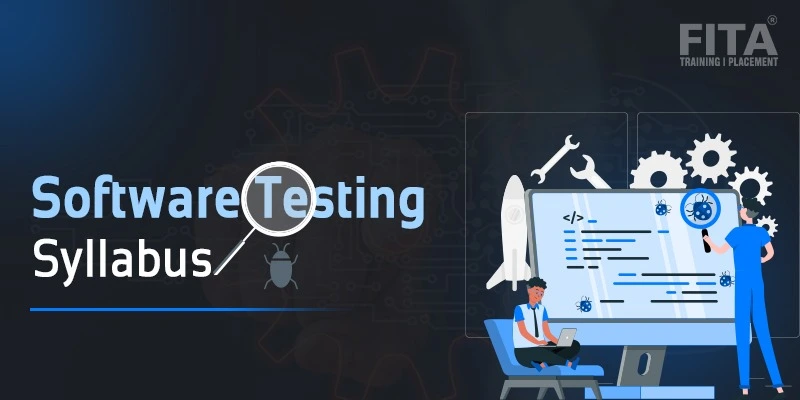
The Software Testing course in FITA Academy gives all facets of the subject, which are well thought out to provide an in-depth understanding of Software Testing. Let us look at the Software Testing Syllabus covered under our Software Testing Course.
Software Lifecycle Models
First and foremost, you will learn about different software lifecycle models. In addition to the traditional Waterfall Model, you will discuss need verification-focused V, and the step-by-step Incremental model. Other models that would be discussed are RAD for rapid development, the Agile model with flexibility as its mantra, the Iterative model based on repetition, and the Spiral model that is risk-oriented. You will get in-depth information regarding the characteristics and areas of application for each model.
- Waterfall model
- V model
- Incremental model
- RAD model
- Agile model
- Iterative model
- Spiral model
Introduction to Testing
This introduction to testing will teach you why testing is necessary and what a Software Testing Life Cycle is. You’ll study verification and validation and find out the differences in testing a desktop, web, or mobile application. This shall be useful in giving you an overview of software testing so that, as a software tester, you can succeed.
- Why Testing
- STLC – Software Testing Life Cycle
- Verification and Validation
- Desktop, Web and Mobile Applications Testing
If you are searching for the perfect Software Testing Course in Chennai, join FITA Academy.
Test Strategy & Test Planning with a Live Project
In this section of the Software Testing Course Syllabus, you will gain hands-on experience in crafting an effective test strategy, preparing a comprehensive test plan document, and working with clarification documents. Additionally, you will become familiar with test design principles. This is what you’ll learn to ensure you are well-equipped for real-world testing scenarios.
- Working on Test Strategy
- Preparing the Test Plan document
- Clarification Document
- Getting Familiar with Test Design
Preparing a Test Case Document
In this section of the Software Testing Course Syllabus at FITA Academy, you’ll master the art of creating comprehensive Test Case Documents. You’ll explore techniques like Boundary Value Analysis (BVA), Equivalence Partitioning (EP), Decision Table Testing, State Transition Diagrams, and Use Case Testing. Additionally, you’ll learn to apply coverage metrics such as Statement Coverage, Branch Coverage, Path Coverage, and LCSAJ to ensure thorough testing of software functionalities.
- Boundary Value Analysis (BVA)
- Equivalence Partitioning (EP)
- Decision Table Testing
- State Transition Diagrams
- Use Case Testing
- Statement Coverage
- Branch Coverage
- Path Coverage
- LCSAJ
Testing Executing
In this module of the Testing Course Syllabus, you’ll delve into testing execution, mastering the process of implementing test plans, executing test cases, and validating software functionality. This hands-on experience will equip you with the necessary skills to identify bugs, assess system performance, and ensure software quality meets rigorous standards.
Test Cases Test
Here, you’ll delve into creating precise test cases that outline conditions, inputs, and expected outcomes. This skill ensures thorough coverage of software functionality, helping to detect defects early and enhance overall system reliability. You’ll also learn strategic test planning to prioritize tests based on risk and impact, optimizing resources for effective software quality assurance.
Join the Software Testing Course in Bangalore and get upskilled in Software Testing.
Reporting
Reporting refers to the clear and concise summary of test results into reports, detailing identified issues and their severity. These reports will turn out very useful in decision-making by giving relevant stakeholders actionable insight into the quality of a product and its fitness for release to the targeted end-users. Effective reporting ensures transparency and facilitates collaboration amongst teams for improved product reliability, ensuring that test results are communicated accurately. Enrolling in a Software Testing Course can greatly help you learn about the above concept.
Defects Tracking Mechanism and Life Cycle
In this module, you will get familiar with the Defects Tracking Mechanism and its Life Cycle, and erotica the process of identifying, prioritizing, fixing, and retesting of dissects. This is important to ensure that the quality of the software is maintained and project workflows go smoothly by ensuring that all problems are managed and resolved.
Defect Categorization
In this section, you’ll master defect categorization techniques, learn precise guidelines for assessing defect security levels, and understand how to determine bug priorities effectively. These skills are crucial for ensuring robust software quality assurance practices. A Software Testing Tutorial will give you a complete idea about this topic.
- Guidelines On Deciding The Security Of A Defect
- Guidelines On Deciding The Priority Of Bug
Cost of Quality
You’ll learn about the Cost of Quality in software testing, exploring how it impacts project budgets and timelines. Understanding these costs helps in making informed decisions to optimize testing efforts and overall project success.
Join the Software Testing Course in Pondicherry to learn comprehensively about Software Testing.
Defect Management
You’ll learn about Defect Management in software testing, including how to identify, report, prioritize, track, and resolve defects throughout the software development lifecycle. Understanding these processes is essential for maintaining product quality and ensuring smooth project execution.
Bugzilla Software Testing Techniques
In this section of the Software Testing Automation Syllabus, you will learn about Bugzilla and master essential software testing techniques like static testing for early defect detection, dynamic testing to evaluate software behavior, and both white box (structure testing) and black box testing to ensure robust functionality and user satisfaction. Knowledge about Bugzillla can greatly help you land a job and earn a substantial Software Tester Salary For Freshers.
- Static Testing
- Dynamic Testing
- White Box Testing/ Structure Testing
- Black Box Testing
Types of Testing – Functional Testing
In this section of the Software Testing Course Syllabus, you will learn about Functional testing and explore a range of critical testing types. This includes Unit Testing, Integration Testing, Smoke Testing, System Testing, Regression Testing, User Acceptance Testing, Globalization Testing, and Localization Testing. These modules equip you with essential skills to ensure software functionality across various stages and user environments. Functional Testing is one of the most commonly discussed topics in Software Testing Interview Questions and Answers.
- Unit Testing
- Integration Testing
- Smoke Testing
- System Testing
- Regression Testing
- User Acceptance Testing
- Globalization Testing
- Localization Testing
Types Of Testing – Non-Functional Testing
You will also learn about Performance Testing, which is a measure of how quick a system is in responding when it is under load. There is also Compatibility Testing to ensure software works in varied environments and Data Migration and Conversion to confirm whether the data transferred is accurate. Other areas of study include Security/Penetration Testing for finding vulnerabilities, Usability Testing for better user experiences, and Install/uninstall testing for the smooth setting up and removal of software. Referring to Software Testing Books can help you learn more about non functional testing.
- Performance Testing
- Compatibility Testing
- Data Migration Testing
- Data Conversion Testing
- Security/Penetration Testing
- Usability Testing
- Install/Un-Install Testing
Automation Testing
In this section of the Automation Testing Syllabus, you’ll learn the importance of test automation, how to conduct automation feasibility analysis, and the essentials for planning and design. You will know setting up a Test Environment, followed by generating your Automation Scripts, executing tests, and analyzing and fixing Defects.
- Why Test Automation
- Automation Feasibility Analysis
- Planning And Design
- Test Environment Setup
- Automation Script Generation
- Test Execution
- Defect Analysis & Fixing
- Cost Involved In Automation
- Automation Applied To Different Types Of Testing
Upskill in Software Testing with FITA Academy’s Software Testing Course in Coimbatore.

